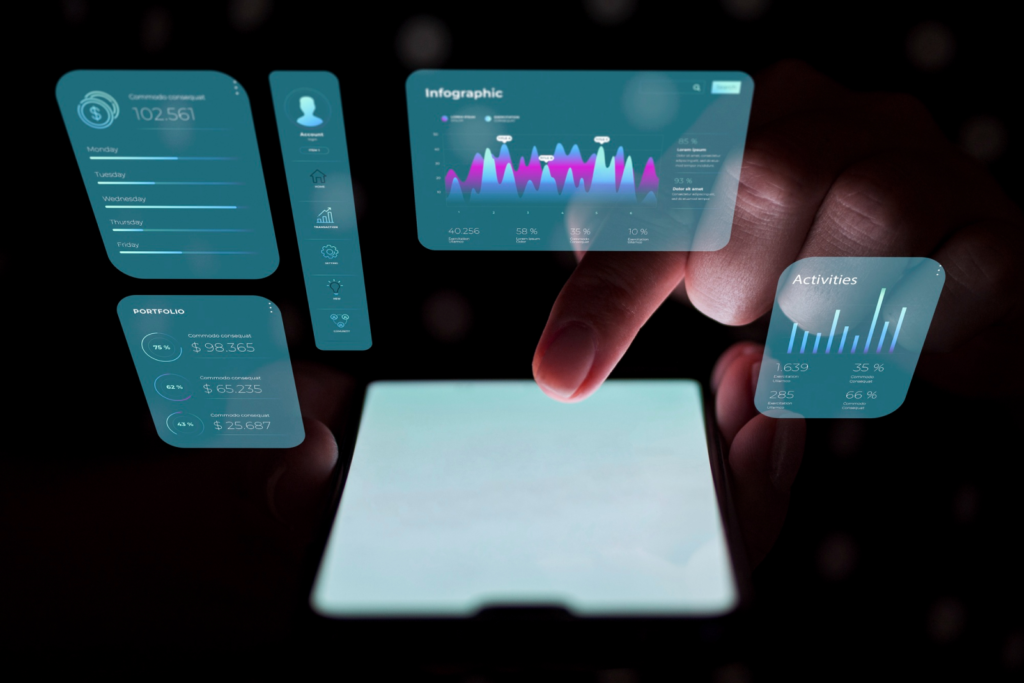
AI is revolutionizing UI/UX design, altering how designers work and creating fresh prospects and hurdles. Join us in this blog as we explore AI’s impact on UI/UX, available tools, and strategies for designers to excel in this evolving field.
“Deciphering the Synergy: AI’s Role in Elevating UI/UX Design”
AI’s influence on UI/UX design hinges on understanding its capabilities.

AI revolutionizes UI/UX design by automating tasks, analyzing data for valuable insights, tailoring experiences to users, and crafting design elements. Here are key domains where AI has reshaped UI/UX:
Automation: AI automates repetitive tasks like generating design variations, resizing images, and optimizing layouts, enabling designers to concentrate on creative and strategic aspects of their work.
Data-driven Insights: AI algorithms analyze large datasets to uncover user behaviors, preferences, and patterns, informing UI/UX improvements, content strategy, and feature prioritization.
Personalization: AI facilitates personalized user experiences through dynamic adaptation of content, layout, and functionality, boosting engagement and satisfaction.
Natural Language Processing (NLP): NLP enhances interface design, facilitating intuitive interactions via voice, chatbots, or text inputs, resulting in more human-like experiences.
Computer Vision: Computer vision algorithms empower UI/UX designers to analyze visual content for insights, including image recognition, content tagging, and aesthetic assessment.
“Revolutionizing User Interaction: AI-Fueled Design Tools and Resources”

AI-infused UI/UX design unlocks tools, resources, turbocharges workflows, ignites creativity, and enhances user experience. Explore intriguing examples.
Adobe Sensei: Adobe’s Sensei AI platform enhances design tools like Photoshop, Illustrator, and XD with AI for tasks including image editing, font matching, and layout adjustments.
Sketch Together: This AI-powered whiteboarding tool enhances remote design sessions by converting hand-drawn sketches into digital wireframes and offering real-time design feedback.
Figma Plugins: Figma boasts a burgeoning plugin ecosystem integrating AI for diverse design tasks like generating variations, crafting color schemes, and proposing layout enhancements.
Voiceflow: Voiceflow simplifies building conversational interfaces for voice assistants like Alexa or Google Assistant through AI-powered design and prototyping
InVision V7: InVision’s latest version integrates AI-driven Design System Manager for automated maintenance of design consistency across projects.
“Exploring the AI-Enhanced Road to User-Centric Design Excellence”

As AI reshapes UI/UX, designers must adapt and learn new skills to succeed. Here are pathways for navigating this transformation:
Embrace Lifelong Learning: Stay updated on AI, design trends, and best practices through online courses and platforms like Coursera, Udemy, and Designmodo.
Master AI-powered Tools: Master AI design tools through experimentation, leveraging tutorials and documentation for guidance.
Develop Data Literacy: Master data analysis, interpretation, and visualization for optimal utilization of AI insights, utilizing tools such as Google Analytics, Hotjar, or Mixpanel for tracking user interactions and behavior.
Collaborate Across Disciplines: Develop communication and collaboration skills for effective interdisciplinary teamwork in AI-driven design projects.
Ethical Considerations: When using AI in UI/UX, designers need to think about ethics, like privacy and fairness, and stay updated on guidelines such as Google’s AI Principles and the IEEE’s ethics initiative.
Key Insights

AI is fundamentally reshaping the UI/UX profession by automating tasks, providing data-driven insights, enabling personalization, and facilitating natural interactions.
Designers who embrace AI-powered tools and techniques, cultivate interdisciplinary skills, and remain mindful of ethical considerations will be well-positioned to thrive in this rapidly evolving landscape.
By staying curious, adaptable, and committed to lifelong learning, UI/UX designers can harness the transformative potential of AI to create innovative and impactful user experiences.ss, and stay updated on guidelines such as Google’s AI Principles and the IEEE’s ethics initiative.



Such a valuable insights. Good to go @anisha
Tnx for sharing this information
A great insight into AI’s role in UX UI!
A very useful perspective in the field of UI/UX
Informative and engaging. Keep up the good work!
I appreciated your emphasis on simplicity and clarity in UI/UX design. It’s easy to get carried away with flashy elements, but your reminder to prioritize usability really resonated with UI/UX teams. Thanks for sharing these valuable tips